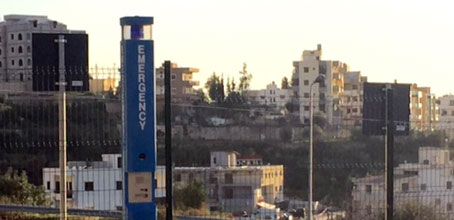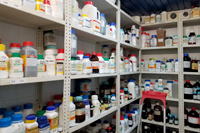Facilities Management FM
Plan, Build, Operate and MaintainEnvironmental Health and Safety

LAU is committed to anticipating environmental health and safety requirements and risks and to developing mitigation strategies to reduce negative effects on people and property.
Laboratories Safety Related Measures
To minimize potential accidents in laboratories, the NSD Laboratory Best Practices Committee (DLBPC) has been formed with the mandate of preparing relevant policies and procedures.
Standard Operating Procedures should be adopted when handling hazardous materials, proper Personal Protective Equipment (PPE) should be worn, and safety related measures should be constantly implemented.
Natural Sciences Laboratories Safety Related Measures
The following Basic Laboratory Safety Rules shall always be adopted:
- Walk — never run — inside the labs.
- Wear appropriate lab clothing (closed shoes, lab coat, back tied hair, goggles).
- Handle chemicals cautiously ( wear gloves, never smell or taste chemicals for identification, make sure to inform your instructor in case of a spill).
- Do not leave lit bunsen burners unattended.
- Make sure no flammable solvents are in the surrounding area when lighting a flame.
- If chemicals or particles get into your eyes, walk to the nearest eye wash and make sure to rinse your eyes for 15 continuous minutes. Try to keep your eyes open while rinsing them.
- If chemicals get onto your skin, walk to the nearest emergency shower, pull the handle and stand under the water for 15 continuous minutes
- Do not eat or drink inside the lab.
- Clean up your lab table once your lab session is over.
- Wash hands after removing gloves and before leaving the lab.
Hazardous Waste Management Plan

A Hazardous Waste Management Plan Committee (HWMC) has been established to work on a comprehensive hazardous waste management plan covering both LAU and LAU Medical Center-Rizk Hospital. The plan will tackle the minimization of hazardous waste generation, segregation and storage in appropriate areas, the packaging and labeling of containers, transportation from the generating area to the storage area, and transportation from LAU and LAU Medical Center-Rizk Hospital to a certified high incineration treatment facility.
Residence Halls
Going to university is an exciting time for students and their parents. Living in a new “home away from home” gives young adults more freedom to make their own choices. But it also gives them an increased level of personal responsibility.
It’s important for students living in on-campus housing to be mindful of fire safety. General Safety Training at the beginning of each academic year is mandatory, as is abiding by the safety rules in compliance with local and international codes and standards.
Each time the general alarm is initiated, all occupants are required to leave the dorms and remain in the designated assembly area, even if the alarm is a drill or false alarm.
Dorm occupants should follow the following safety tips:
- Check the evacuation map when you check into your room for the first time. Locate yourself in the building and identify your exits.
- Never disable a smoke detector
- Never tamper with safety system components
- When you are cooking, turn on the hood to avoid false alarms and remain in the kitchen
- Do not cook when you are sleepy or drowsy
- Avoid flammable holiday decorations
- Do not smoke inside the building
- Practice all fire drills as if they were real emergencies
